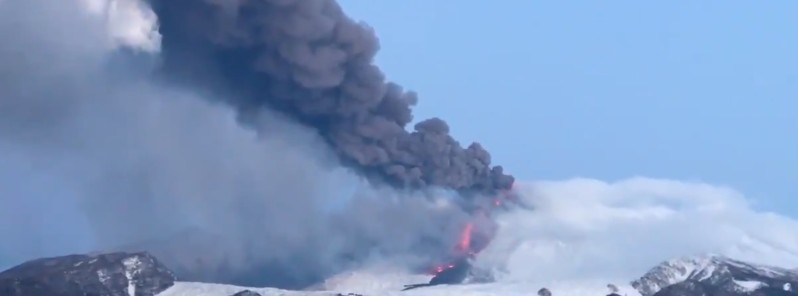14th paroxysmal eruptive episode at Etna since February 16, Italy

Strombolian activity at Etna volcano, Italy intensified again at 00:55 UTC on March 17, 2021, and evolved over the next couple of hours into the 14th paroxysmal eruptive episode since February 16. The Aviation Color Code was raised to Red at 02:26 UTC and lowered back to Orange at 09:29.
Strong strombolian activity transformed into lava fountaining at 02:17 UTC, however, due to cloud cover it was not possible to continuously observe the ongoing activity. Ash cloud moved to the SE but its height was not estimable, Etna Volcano Observatory said.
Surveillance cameras at 02:25 UTC showed lava overflow from the Southeast Crater toward Valle del Bove.
The eruption was accompanied by a loud rumble through the night, which generated a lot of fear among the local population.
According to the INGV report issued at 06:17 UTC, lava fountaining has come to an end, with only moderate strombolian activity persisting.
[Mio video] #Etna, nuova #eruzione, la #lava sul #vulcano innevato e una enorme nube di gas, cenere e lapilli verso sud-est. Oggi, ore 5,58 #Parossismo numero 14 dal 16 febbraio scorso #paroxysm #eruption #plume #tephra #ash #volcano pic.twitter.com/sUsguWPh2A
— Turi Caggegi (@TuriCaggegi) March 17, 2021
Geological summary
Mount Etna, towering above Catania, Sicily's second-largest city, has one of the world's longest documented records of historical volcanism, dating back to 1500 BCE.
Historical lava flows of basaltic composition cover much of the surface of this massive volcano, whose edifice is the highest and most voluminous in Italy.
The Mongibello stratovolcano, truncated by several small calderas, was constructed during the late Pleistocene and Holocene over an older shield volcano. The most prominent morphological feature of Etna is the Valle del Bove, a 5 x 10 km (5.1 x 6.2 miles) horseshoe-shaped caldera open to the east.
Two styles of eruptive activity typically occur at Etna. Persistent explosive eruptions, sometimes with minor lava emissions, take place from one or more of the three prominent summit craters, the Central Crater, NE Crater, and SE Crater (the latter formed in 1978).
Flank vents, typically with higher effusion rates, are less frequently active and originate from fissures that open progressively downward from near the summit (usually accompanied by strombolian eruptions at the upper end).
Cinder cones are commonly constructed over the vents of lower-flank lava flows. Lava flows extend to the foot of the volcano on all sides and have reached the sea over a broad area on the SE flank. (GVP)
Featured image: Eruption at Etna volcano on March 17, 2021. Credit: Turi Caggegi

Commenting rules and guidelines
We value the thoughts and opinions of our readers and welcome healthy discussions on our website. In order to maintain a respectful and positive community, we ask that all commenters follow these rules.